S-train
The S-train is a type of hybrid urban-suburban rail serving a metropolitan region. Some of the larger S-train systems provide service similar to rapid transit systems, while smaller ones often resemble commuter or even regional rail. They are especially common in Germany and Austria, where they are known as S-Bahn, which in the 1930s was an abbreviation of either Schnellbahn, Stadtbahn or Stadtschnellbahn, depending on the city, but they must not be confused with U-Stadtbahnen.[1] Similar S-train systems exist also in Switzerland known as S-Bahn as well. In Denmark, they are known as S-tog [ˈesˌtsʰɔˀw], in the Czech Republic as Esko or S-lines, and northern Italy as Servizio ferroviario followed by either the word "metropolitano" (in Turin) or "suburbano" (in Milan).
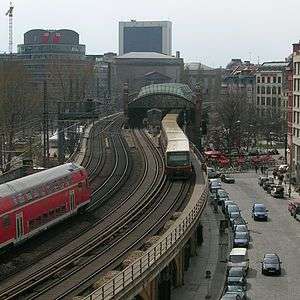
Characteristics
There is no complete definition of an S-train system. S-trains are, where they exist, the most local type of railway stopping at all existing stations inside and around a city, while other mainline trains only call at major stations. They are slower than mainline railways but usually serve as fast crosstown services within the city. S-trains generally service the hinterland of a certain city, rather than connecting different cities, although in high population density areas a few exceptions from this exist. A good example of a such exception is the Rhine-Ruhr S-Bahn, which interconnects the cities, towns and suburbs of the Ruhr, a large urban agglomeration, not unlike the large net of regional trains which also serve the area. Most S-train systems are entirely built on older local railways, or in some cases parallel to an existing dual track railway. Most use existing local mainline railway trackage, but a few branches and lines can be purpose built S-train lines.[2][3] S-trains typically use overhead lines or a third rail for traction power. In Hamburg the S-trains use both the methods, depending on which line is powered.[4]
In smaller S-train systems and suburban sections of larger ones, S-trains typically share tracks with other rail traffic, with the Berlin S-Bahn, Hamburg S-Bahn and Copenhagen S-train being notable exceptions. Busy S-train corridors sometimes have sections of exclusive trackage of their own but parallel to mainline railways. Many of the larger S-train systems will also have central corridors of exclusive trackage that individual suburban branches feed into, creating high frequency corridors. In many cases, the central corridor is a dedicated underground line in the city center with close stop spacing and a high combined frequency similar to metro systems. A good example of this is the Berliner Stadtbahn in the Berlin's S-Bahn, which is regarded as a tourist attraction.[5][6] However, in more lightly used sections outside the city center, S-trains commonly share tracks with other train types.
Further out from the central parts of a city the individual services branch off into lines where the distances between stations can exceed 5 km, similar to commuter rail. This allows the S-train to serve a dual transportation purpose: local transport within a city center and suburban transport between central boroughs of larger cities, and to suburbs. Frequencies vary wildly between systems with short headways in the core sections of large networks to headways of over 20 minutes in remote sections of the network, late at night and/or on Sundays and in smaller systems. The rolling stock typically used in S-Trains reflect its hybrid purpose. The interior is designed for short journeys with provision for standing passengers but may have more space allocated to larger and more numerous seats. Integration with other local transport for ticketing, connectivity and easy interchange between lines or other system like metros is typical for S-trains. Where both S-train and metro exist, the number of interchange stations between the two systems is substantial with metro tickets being valid on S-trains, and vice versa. The S-Bahn Mitteldeutschland constitutes the main local railway system for Leipzig but also connects to Halle, where a few stations are located. The Rostock S-Bahn is an example of a smaller S-Bahn system.
Etymology
Germany, Austria and Switzerland
The name S-Bahn (S-train) is an abbreviation for the German "Stadtschnellbahn" (meaning "city rapid railway") and was introduced in December 1930 in Berlin. The name was introduced at the time of the reconstruction of the suburban commuter train tracks— the first section to be electrified was a section of the Berlin–Szczecin railway from Berlin Nordbahnhof to Bernau bei Berlin station in 1924, leading to the formation of the Berlin S-Bahn.[7]
The main line Berlin Stadtbahn (English: City railway of Berlin) was electrified with a 750 volt third rail in 1928 (some steam trains ran until 1929) and the circle line Berlin Ringbahn was electrified in 1929. The electrification continued on the radial suburban railway tracks along with changing the timetable of the train system into a rapid transit model with no more than 20 minutes headway per line where a number of lines overlapped on the main line. The system peaked during the 1936 Summer Olympics in Berlin to a train schedule below 2 minutes.[8]
The idea of heavy rail rapid transit was not unique to Berlin. Hamburg had an electric railway between the central station ("Hauptbahnhof") and Altona which opened in 1906 and in 1934 the system adopted the S-Bahn label from Berlin. The same year in Denmark, Copenhagen's S-tog opened its first line. In Austria, Vienna had its Stadtbahn main line electrified in 1908 and also introduced the term Schnellbahn ("rapid railway") in 1954 for its planned commuter railway network (which started operations in 1962). The S-Bahn label was sometimes used as well, but the name was only switched to S-Bahn Wien in 2005. As for Munich, a first breaking ground for an S-train-like rapid transport system, executed by the Nazi government of Adolf Hitler, took place in 1938 in Lindwurmstrasse near what is now Goetheplatz underground station (line U6). Said system was supposed to run through tunnels in downtown areas. The planning process mainly consisted of the bundling and interconnecting of existing suburban and local railways, plus the construction of a few new lines. Plans and construction work - including the building shell of Goetheplatz station - came to a very early halt during World War II and were not pursued in its aftermath. Very extensive nowadays, Munich's existing S-Bahn-System, together with the first two U-Bahn lines, began to operate prior to the 1972 Summer Olympics only.
The term S-Bahn was until 14 March 2012 a registered wordmark of Deutsche Bahn, where at the request of a transportation association the Federal Patent Court of Germany ordered the wordmark to be removed from the records of the German Patent and Trade Mark Office.[9] Prior to the said event Deutsche Bahn collected a royalty of 0.4 cents per train kilometer for the usage of the said term.
Denmark
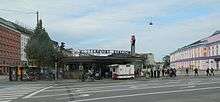
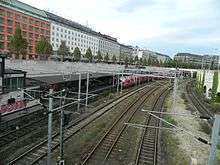

The "S" stood for "station". Just before the opening of the first line in the Copenhagen S-train network, the newspaper Politiken on 17 February 1934 held a competition about the name, which in Danish became known as Den elektriske enquete or "The electrical survey" (as the Copenhagen S-trains would become the first electrical railways in Denmark). But since an "S" already was put up at all the stations, weeks before the survey, the result became S-tog which means "S-train".[10] This was also just a few years after the S-trains had opened in Berlin and Hamburg. Today the Copenhagen S-trains uses six lines and serves 85 stations, 32 of them are located inside the (quite tiny) municipality borders. Each line uses 6 t.p.h (trains per hour) in each direction, with exception of the (yellow) F-line. The F-line have departures in each direction every five minutes, or 12 t.p.h. service .[11]
History
Germany
Early steam services
In 1882, the growing number of steam-powered trains around Berlin prompted the Prussian State Railway to construct separate rail tracks for suburban traffic. The Berliner Stadtbahn connected Berlin's eight intercity rail stations which were spread throughout the city (all but the Stettiner Bahnhof which today is a pure S-train station known as Berlin Nordbahnhof; as the city Stettin today is Polish city Szczecin). A lower rate for the newly founded Berliner Stadt-, Ring- und Vorortbahn (Berlin City, Circular and Suburban Rail) was introduced on 1 October 1891. This rate and the growing succession of trains made the short-distance service stand out from other railways.
The second suburban railway was the Hamburg-Altonaer Stadt- und Vorortbahn connecting Hamburg with Altona and Blankenese. The Altona office of the Prussian State Railway established the electric powered railway in 1906.[12]
Electricity
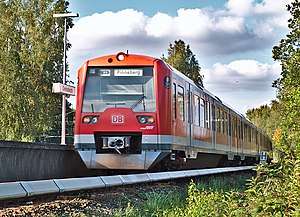
The beginning of the 20th century saw the first electric trains, which in Germany operated at 15,000 V on overhead lines. The Berliner Stadt-, Ring- und Vorortbahn instead implemented direct current multiple units running on 750 V from a third rail. In 1924, the first electrified route went into service. The third rail was chosen because it made both the modifications of the rail tracks (especially in tunnels and under bridges) and the side-by-side use of electric and steam trains easier.[12]
To set it apart from the subterranean U-Bahn, the term S-Bahn replaced Stadt-, Ring- und Vorortbahn in 1930.
The Hamburg service had established an alternating current line in 1907 with the use of multiple units with slam doors. In 1940 a new system with 1200 V DC third rail and modern electric multiple units with sliding doors was integrated on this line (on the same tracks). The old system with overhead wire remained up to 1955. The other lines of the network still used steam and later Diesel power. In 1934, the Hamburg-Altonaer Stadt- und Vorortbahn was renamed as S-Bahn.
Comparable Systems


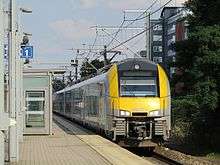

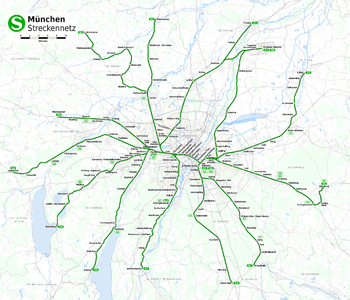
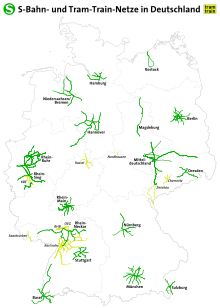
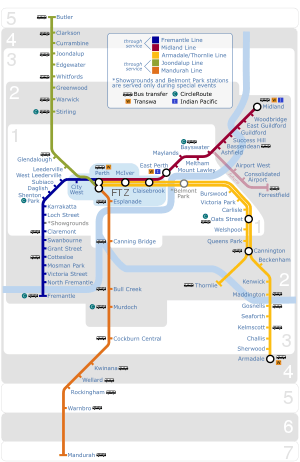
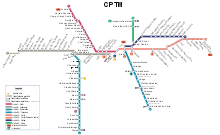
Australia
The Sydney Trains suburban rail network consists of nine lines converging in the underground City Circle with frequencies as high as three minutes in this section, 5–10 minutes at most major stations all day and 15 minutes at most minor stations all day.
Melbourne's rail network features sixteen electrified commuter rail lines traversing the city centre in the underground City Loop providing a metro-like service in the central core. A second underground core is under construction, as the Metro Tunnel project.
Commuter rail services in Brisbane are provided under the Queensland Rail City network brand, featuring twelve electrified lines converging in the city centre. Cross River Rail is an under construction underground cross-city tunnel to relieve pressure on this network.
Transperth Trains operates commuter rail services in the Perth metropolitan area, with the Joondalup railway line and Mandurah railway line operating at metro-like frequencies.
Austria
The oldest and largest S-Bahn system in Austria is the Vienna S-Bahn, which predominantly uses non exclusive rails tracks outside of Vienna. It was established in 1962, although it was usually referred to as Schnellbahn until 2005. The white "S" on a blue circle used as the logo is said to reflect the layout of the central railway line in Vienna. However, it has now been changed for a more stylized version that is used all through Austria, except Salzburg. The rolling stock was blue for a long time, reflecting the logo colour, but red is used uniformly for nearly all local traffic today.
In 2004, the Salzburg S-Bahn went into service as the first Euroregion S-Bahn, crossing the border to the neighbouring towns of Freilassing and Berchtesgaden in Bavaria. The network is served by three corporations: the Berchtesgadener Land Bahn (BLB)(S4), the Austrian Federal Railways (German: Österreichischen Bundesbahn / ÖBB)(S2 and S3) and the Salzburger Lokalbahn (SLB)(S1 and S11) and . The Salzburg S-Bahn logo is only different one, it is a white S on a light blue circle.
In 2006 the regional train line in the Rhine Valley in the state of Vorarlberg has been renamed to S-Bahn Vorarlberg. It is a three lines network, operated by the Montafonerbahn and the ÖBB.
The S-Bahn Steiermark has been inaugurated in December 2007 in Styria, built to connect its capital city Graz with the rest of the metropolitan area, currently the following lines are active: S1, S11, S3, S31, S5, S51, S6, S61, S7, S8 and S9. The network is operated by three railway companies: the Graz-Köflacher Bahn (GKB) (lines: S6, S61 and S7), the ÖBB (lines: S1, S3, S5, S51, S8 and S9) and the Steiermärkische Landesbahnen (StB) (lines: S11 and S31).
In December 2007 as well the Tyrol S-Bahn opened, running from Hall in Tirol in the east to Innsbruck Central Station and Telfs in the west and from Innsbruck to Steinach am Brenner. Class 4024 EMUs are used as rolling stock on this network.
In 2010 the S-Bahn Kärnten was opened in the state of Carinthia and currently consists of 4 lines operated by ÖBB.
The youngest network is the S-Bahn Oberösterreich in the Greater Linz area of the state of Upper Austria, which was inaugurated in December 2016. It is a 5 line system operated by Stern und Hafferl and the ÖBB.
Belgium
The suburban railways of Brussels are currently being integrated into the Brussels Regional Express Network (French: Réseau Express Régional Bruxellois, RER; Dutch: Gewestelijk ExpresNet, GEN), which is identified by the letter S across both languages.[13] In 2018, the S-train was also introduced in Antwerp, Ghent, Liège and Charleroi.[14]
Brazil
In São Paulo, the Companhia Paulista de Trens Metropolitanos suburban rail network operates at high frequencies on tracks used exclusively for commuter traffic.
SuperVia provides electrified commuter rail services in Rio de Janeiro.
Czech Republic
In the Czech Republic, integrated commuter rail systems exist in Prague[15] and Moravian-Silesian Region. Both systems are called Esko, which is how S letter is usually called in Czech. Esko Prague has been operating since 9 December 2007 as a part of the Prague Integrated Transport system. Esko Moravian-Silesian Region began operating on 14 December 2008 as a part of the ODIS Integrated Transport system serving the Moravian-Silesian Region. Both systems are primarily operated by České dráhy. Several shorter lines are operated by other companies.
Denmark
Copenhagen S-train connects the city centre, other inner and outer boroughs and suburbs with each other. The average distance between stations is 2.0 km, shorter in the city core and inner boroughs, longer at the end of lines that serve suburbs. Of the 85 stations, 32 are located within the central parts of the city. Some stations are located around 40 km from Copenhagen city centre. For this reason the fares vary depending on distances. One-day-passes which tourist buy are valid only in the most central parts of the S-train system. Weekdays each line have departures every 10th minute with exception for the F-line, which departures every fifth minute. Where several lines use the same branches, up to around 30 trains per hour (in each direction) service exists. On Sundays the seven lines are reduced to four lines, but all stations are served at least every 10th minute. The three railway stations at Amager has a local service that equals the S-trains'.
The Copenhagen Metro opened in 2002 as a complement to the already existing S-train system. Copenhagen's S-train system is the only one in the country. Outside Denmark, in cities where both exist, is it far from unusual that a metro system later has been complemented with S-trains. The branch towards Køge (the southernmost S-train station in Copenhagen's S-network) has a rather unique history, as it was built in the 1970s where no previous railway ever had existed.
Finland
The Helsinki commuter rail network is completely electrified with exclusive tracks running parallel to mainline rail tracks. The Ring Rail Line operates at ten-minute frequencies.
France
The term Réseau Express Régional (lit. Regional Express Network) originally meant the Paris system, but is now used for other French networks as well. However, only the Paris RER has underground corridors that operate with frequency and stop spacing of a rapid transit system similar to an S-Train.
Germany
The trains of the Berlin and Hamburg S-Bahn systems ran on separate tracks from the beginning. When other cities started implementing their systems in the 1960s, they mostly had to use the existing intercity rail tracks, and they still more or less use such tracks.
The central intercity stations of Frankfurt, Leipzig, Munich and Stuttgart are terminal stations, so all four cities have monocentric S-Bahn networks. The S-Bahn trains use a tunnel under the central station and the city centre.
The high number of large cities in the Ruhr area promotes a polycentric network connecting all cities and suburbs. The S-Bahn Rhein-Ruhr, as it is called, features few tunnels, and its routes are longer than those of other networks. The Ruhr S-Bahn is the only S-Bahn network to be run by more than one corporation in Germany, and the Salzburg S-Bahn holds a similar distinction in Austria. Most Swiss S-Bahn systems are multi-corporation networks, however.
Most German S-Bahn networks have a unique ticket system, separated from the Deutsche Bahn rates, instead connected to the city ticket system used for U-bahns and local busses. The S-Bahn of Hanover, however, operates under five different rates due to its large expanse.
One S-Bahn system is no longer in operation: the Erfurt S-Bahn which operated from 1976 until 1993 and was an 8.6 km (5.3 mi) single-line system which consisted of four stations from Erfurt Central Station to Erfurt Berliner Straße station in the then newly built northern suburbs of Erfurt.
There are several S-Bahn or S-Bahn-like systems in planning, such as the Danube-Iller S-Bahn and the Augsburg S-Bahn. The S-Bahn system in Lübeck is under discussion (see network plan).
The Stadtbahn Karlsruhe (a tram-train network) uses the green "S" logo, but does not refer to itself as S-Bahn. The blue U-Bahn logo is not used either, due to the lack of subterranean lines.
Despite their names, the Ortenau S-Bahn (Offenburg) is a Regionalbahn service.
The following networks are currently in operation:
| S-Bahn | Area of Responsibility | Authority | Opened | Lines | Kilometrage | Rolling Stock | Company | Expiry of contract |
|---|---|---|---|---|---|---|---|---|
| Berlin S-Bahn | Berlin, Potsdam | VBB | 1924 | 16 | 331 km | 480, 481, 485 | S-Bahn Berlin GmbH | 2017 |
| Breisgau-S-Bahn | Freiburg im Breisgau | RVF | 1997[upper-alpha 1] | 7 | 50 km | Alstom Coradia Continental, Stadler Regio-Shuttle RS1 | DB Regio AG (electric), SWEG (diesel) | |
| Bremen S-Bahn | Bremen, Bremerhaven, Oldenburg | VBN | 2010 | 4 | 270 km | Alstom Coradia Continental | NordWestBahn | 2021 |
| Dresden S-Bahn | Dresden | VVO | 1992 | 3 | 128 km | 143 + Doppelstockwagen, 146.0 + Doppelstockwagen | DB Regio Südost | 2027 |
| Hamburg S-Bahn | Hamburg | HVV | 1934 | 6 | 144 km | 472, 474, 490 | DB Regio AG | 2033 |
| Hannover S-Bahn | Hannover, Paderborn, Hildesheim, Minden | GVH, nph | 2000 | 9 (+ 1) | 385 km | 424, 425 | DB Regio Nord | 2020 |
| Mitteldeutschland S-Bahn | Leipzig, Halle (Saale), Zwickau, Bitterfeld, Wurzen, Borna | MDV, VBB, VMS, VVO | 2013 | 10 | 802 km | Bombardier Talent 2, 143 + Doppelstockwagen | DB Regio Südost | 2025/2030 |
| Mittelelbe S-Bahn | Magdeburg | marego | 1974 | 1 | 130 km | 425 | DB Regio Südost | 2028 |
| Munich S-Bahn | Munich and surrounding counties | MVV | 1972 | 8 | 434 km | 423, 420 | DB Regio AG | 2017 |
| Nürnberg S-Bahn | Nürnberg, Bamberg | VGN | 1987 | 4 | 227 km | 143 + x-Wagen, Bombardier Talent 2 | DB Regio Bayern | 2030 |
| Ortenau-S-Bahn | Offenburg, Straßburg | TGO | 1998 | 4 | 170 km | Stadler Regio-Shuttle RS1 | SWEG | |
| Rhine-Main S-Bahn | Frankfurt am Main, Wiesbaden, Mainz, Darmstadt, Offenbach am Main | RMV | 1978 | 9 | 303 km | 423, 430 | DB Regio AG | 2029, 2036 |
| RheinNeckar S-Bahn | Mannheim, Karlsruhe, Ludwigshafen am Rhein, Heidelberg, Kaiserslautern | VRN, KVV, HNV, saarVV | 2003 | 7 | 370 km | 425 | DB Regio Südwest | 2017, 2033 |
| Rhein-Ruhr S-Bahn (Ruhrschnellverkehr) S-Bahn Köln |
Ruhrgebiet (esp. Duisburg, Essen, Bochum, Dortmund, Düsseldorf, Wuppertal) Rheinland (Köln, Bonn) |
VRR VRS |
1967 (1932) 1975 |
14 | 717 km | 143 + x-Wagen, 420, 422, 423, Bombardier Talent, Alstom Coradia LINT, Alstom Coradia Continental | DB Regio NRW, Regiobahn, Abellio Rail NRW | |
| Rostock S-Bahn | Rostock | VVW | 1974 | 3 | 91 km | Bombardier Talent 2 | DB Regio Nordost | 2024 |
| Stuttgart S-Bahn | Stuttgart, Waiblingen, Esslingen, Ludwigsburg, Böblingen | VVS | 1978 | 7 | 215 km | 423, 430 | DB Regio AG | 2028 |
- first electric services started 2019.
Hong Kong
The three MTR lines which were formerly operated by Kowloon Canton Railway (East Rail Line, West Rail Line, Ma On Shan Line), and the Tung Chung Line connect the new towns in New Territories and the city centre Kowloon together with frequent intervals. Most of the sections of the East and West Rail Lines are overground and some sections of the East Rail Line share tracks with intercity trains to mainland China. These lines are integrated into the MTR network and most passengers do not need to exit and reenter the system through separate fare gates and purchase separate tickets to transfer between such lines and the rest of the network (the exception is between the West Rail Line's East Tsim Sha Tsui station and the Tsuen Wan Line's Tsim Sha Tsui station).
Hungary
Indonesia
KRL Commuterline or Commuter Line Jabodetabek is a commuter railway system serving Jakarta and its satellite cities as well as its regencies. The system currently has 6 lines, 80 stations, and it spans 480km with roughly 300 million passengers annually. The system only accept bank-issued cards and e-tickets which can be purchased or topped up at any stations throughout the system.
Ireland

- Dublin Suburban Rail and DART fill the role of an S-train rail service in Dublin, Ireland, although only DART has the common spine running through the city centre that characterises other European S-train networks, although this runs on an elevated track, rather than underground. The DART Underground project, suspended as of 2019, would upgrade this to a more typical S-train network by the addition of an underground link running through the city's commercial centre to join with existing Western commuter services.
Italy
Several systems in Italy operate quite similar to S-Trains with numerous services funneling into the underground "Passante" or passing railway.
Operating services in the country are:
- Milan suburban railway service, operated by Trenord and ATM has numerous services funneling into the underground Milan Passante railway.
- Turin metropolitan railway service, operated by Ferrovie Regione Piemonte and GTT with an underground railway running through the city, serviced by most lines.
- Naples Metro Line 2 is an underground corridor where commuter rail services operated by Trenitalia traverse and service the urban center.
- Bari metropolitan railway service
Japan
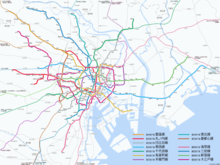
Japan Railways Group (JR) operates train services with different classes on the same line. In Tokyo and Osaka, there are various lines connecting the suburban areas and Central Tokyo by frequent "Local" and "Rapid" services, including Yamanote Line, Keihin Tohoku Line, Joban Line, Chuo Line, Osaka Loop Line, etc.
In addition, Tokyo, Osaka, Nagoya and Fukuoka also boast numerous private railway companies such as Tobu Railway, Meitetsu and Hanshin Electric Railway that operate equally extensive suburban rail networks. Most of them also interoperate their trains into the subway lines in the respective cities like Tokyo Metro and Nagoya Municipal Subway.
Malaysia
Several systems in Malaysia operate quite similar to S-Trains, such as:
- KTM Komuter, operated by Keretapi Tanah Melayu, mainly service in Klang Valley and Greater Penang.
- Express Rail Link, airport s-train service which have shuttle (stop at every station) and bypass (only at KLIA anda KL Sentral) route.
Netherlands
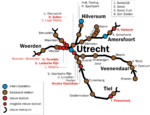
"Randstadspoor" is a network of Sprinter train services in and around the city of Utrecht, similar to S-trains. For the realisation of this network, five new stations were opened: Utrecht Zuilen, Utrecht Terwijde, Utrecht Leidsche Rijn, Utrecht Vaartsche Rijn and Houten Castellum. Extra tracks have been built to create dedicated routes for these Sprinters, so they can call frequently without disturbing high-frequent Intercity services parallel to these routes.[16] Similar systems are planned for The Hague and Rotterdam, the latter of which already has the Rotterdam Metro network.
Poland
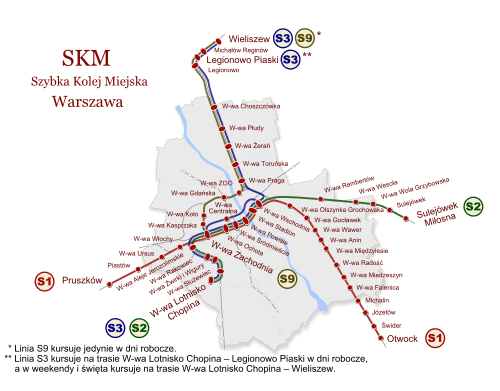
In Poland, three comparable systems exist, but the terms used are "Szybka Kolej Miejska" (fast urban rail) and "kolej aglomeracyjna" (agglomeration rail). These systems are:


- Szybka Kolej Miejska w Trójmieście (eng. Tricity Fast Urban Rail), located in the Tricity/Trójmiasto urban area, the three cities of Gdańsk, Gdynia and Sopot.
Russia
The names "S-Bahn" and "S-Train" is not used in Russia. Officially, such a system is called an "urban electric train", or less often and unofficially "ground metro". These names are often used, even if non-electrified trains or rail buses are used as the rolling stock on the routes. The first similar project, implemented before the revolution, is the Oranienbaum Electric Line in St. Petersburg. Also, an approximate analogue was Beskudnikovskaya railway branch, which existed in Moscow between the 1940s and 1980s. The trains that shuttled along it did not go to the main lines, so it was a city transport. The system of high-speed rail transport, similar to S-Train:
- Moscow Central Circle
- Moscow Central Diameters
- Nizhny Novgorod City Rail
- Ekaterinburg City Rail
- Novosibirsk City Rail
- Kazan City Rail
- Volgograd City Rail
- Sochi City Rail
- Rostov City Rail
- Vladivostok City Rail
- Chelyabinsk City Rail
- Kaliningrad Ground Metro
- Krasnoyarsk City Rail
- Voronezh City Rail
- Belgorod City Rail
- Tambov City Rail
- Perm City Rail
- Ufa City Rail
Serbia
BG Voz is an urban rail system that serves Serbian capital. It is fairly similar to German S-Bahn, but currently has only two lines, with plans for further expansion. Between early 1990s and mid-2010s, there was another system, known as Beovoz, that was used to provide mass-transit service within the Belgrade metropolitan area, as well as to nearby towns, similarly to RER in Paris. Beovoz had more lines and far more stops than the current system. However, it was abandoned in favor of more accurate BG Voz, mostly due to inefficiency. While current lines rely mostly on the existing infrastructure, any further development means furthering capacities (railways expansion and new trains). Plans for further extension of system include another two lines, one of which should reach Belgrade Nikola Tesla Airport.
South Korea
Seoul Subway Line 1 is a collection of frequent surface running Korail commuter railway services that feed into a core 7.8 km long underground section.
Spain
Madrid’s Cercanías commuter rail network runs mostly independently of other rail traffic and features several underground sections.
Rodalies de Catalunya operates Barcelona's suburban rail services which traverse the city centre in two underground trunk routes, the Meridiana Tunnel and Aragó Tunnel.
Cercanías Málaga's C-1 line from Málaga Centro-Alameda to Fuengirola features several underground sections and uses a route mostly separate from the national rail network of Spain, aside from a small section between Málaga-María Zambrano and Victoria Kent.
Sweden
![]()
Switzerland
S-Bahn is also used in German-speaking Switzerland. While French publications of those networks translate it as RER, the line numbers are still prefixed with an S (e. g. S2).
The oldest network in Switzerland is the Bern S-Bahn, established in stages from 1974 and has adopted the term S-Bahn since 1995. It is also the only one in Switzerland to use a coloured "S" logo. In 1990, the Zürich S-Bahn, which covers the largest area, went into service. S-Bahn services were set up in the course of the Bahn 2000 initiative in Central Switzerland (a collaborative network of S-Bahn Luzern and Stadtbahn Zug), St. Gallen (S-Bahn St. Gallen) and Ticino (Rete celere del Canton Ticino).
The Basel trinational S-Bahn services the Basel metropolitan area, thus providing cross-border transportation into both France and Germany. A tunnel connecting Basel's two large intercity stations (Basel Badischer Bahnhof and Basel SBB) is planned as Herzstück Regio-S-Bahn Basel (lit. heart-piece Regio-S-Bahn Basel).
The RER Vaud of Lausanne and the Léman Express of Geneva serve the area around Lake Geneva (fr. Lac Léman). Transborder networks for the Lake Constance-adjacent German states Baden-Württemberg and Bavaria, the Austrian state Vorarlberg and the Swiss cantons St. Gallen and Thurgau are under discussion. Possible names are Bodensee-S-Bahn and Alpenrhein-Bahn.
United Kingdom
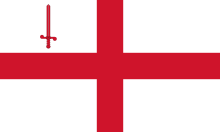
- Crossrail is similar to S-trains with a central core section will be using a new 22 kilometres (14 mi)-long east–west twin tunnel under central London, splitting into two branches at either end.
- Thameslink brings together several branches from northern and southern suburbs and satellite towns in to a high frequency central tunnel underneath London.
- The London Overground, by contrast, skirts through the inner suburbs with lines mostly independent of each other, although there are several branches. The Watford DC line, partly shared with underground trains, uses third rail, but parallels a main line using overhead wires. This arrangement is similar to that found in Berlin. The system's 10 lines are not numbered and do not have distinct colours, but are divided into 6 regions.
- Liverpool
- Merseyrail consists of two lines powered by third rail, both of which branch out at one end. At the other, the Northern Line continues out of the city centre to a mainline rail interchange, while the Wirral Line has a city-centre loop.

- Birmingham's four suburban lines are colour-coded. The green line is diesel while the others are powered by overhead wires.
- Newcastle
- The Tyneside Electrics system existed from 1904 to 1967 using DC third rail. British Rail did not have the budget to maintain the ageing electrification system. The Riverside Branch was closed, while the remaining lines were de-electrified. 13 years later, they were re-electrified using DC overhead wires, and now form the Tyne & Wear Metro Yellow Line.
- Glasgow
- Many of the rail lines around Glasgow are branded as Strathclyde Partnership for Transport. The trains used for these used to carry a different livery from the standard livery used by Scottish trains. The network includes most electrified Scottish rail routes.
- Bristol
- MetroWest is a proposed 5-line network in Bristol, northern Somerset & southern Gloucestershire. The four-tracking of the line between Bristol Temple Meads and Bristol Parkway stations will enable local rail services to be separated from long-distance trains.
United States
- Philadelphia - SEPTA Regional Rail features a tunneled corridor through the city center and through-routed services from several commuter lines. The arrangement of lines through the connection was originally modeled on European S-trains, under a plan proposed by Vukan Vuchic and Shinya Kikuchi in 1984 and 1985.[19][20] However, several of the lines extend well out from the city through less densely populated areas. On the whole, the system is more like a RegionalBahn in scale.
- San Francisco Bay Area - BART has operations similar to an S-Bahn in that both are hybrids between a rapid transit system and a commuter rail system. BART has a main tunneled corridor where services from several branches of suburban surface trackage funnel into. However BART is completely separated from all other traffic and is commonly classified as a rapid transit system.
- New York City - The Metropolitan Transportation Authority operates the Long Island Railroad and Metro North Railroad, commuter rail lines which service points within New York City, along with suburbs. On weekends, riders can purchase a subsidized "city-ticket" which allows them to travel within the New York City fare zone for $4 (one-way).
- New Jersey - The New Jersey Transit Corporation operates 11 commuter rail lines in New Jersey with some trains terminating at NY Penn Station. It primarily services the Northern part of New Jersey, however it also operate a line to Philadelphia and Atlantic City and parts of Orange County and Rockland County in New York. In 2026, with the planned completion of the Gateway Project operating capacity on the Northeast Corridor will double crossing the Hudson river.
See also
References
- See example of this for Stuttgart ("Warum Stuttgart trotz U keine U-Bahn hat" ; literal translation: "Why does Stuttgart despite the U lack a U-Bahn (=Metro/Underground/Subway)
- An example of this is the Køgebugt or Køge-Bay railway at Copenhagen, built 1971 to 1983 "Archived copy". Archived from the original on 3 February 2005. Retrieved 16 May 2005.CS1 maint: archived copy as title (link)
- S-train tunnel at Hamburg between Central Station and Altona 1967-1979
- http://s-bahn-galerie.de/S_Bahn_Hamburg/Geschichte_HH.htm
- http://www.stadtschnellbahn-berlin.de/strecken/01/
- same
- http://www.stadtschnellbahn-berlin.de (in German)
- http://www.stadtschnellbahn-berlin.de (in German); chose "Geschichte" (History)
- Beschluss Bundespatentgericht vom 14. März 2012. Retrieved 14 April 2013.
- John Poulsen: S-bane 1934-2009 side 47
- http://www.dsb.dk/globalassets/pdf/koereplaner/s-tog/2017/s-tog-30jan17.pdf
- See picture of Berliner Stadtbahn by Hackescher Markt S-train station, the third rail is clearly seen between the two S-Train tracks. Original name of that station was "Börse", or "the Stock Market" (which now is located in Frankfurt am Main)
- Alan Hope (15 September 2015). "NMBS releases details of S-train express network". Flanders Today.
- S-train overview in Belgium (in Dutch)
- "Prague Train Map - Prague, Czech Republic". Expats.cz for Jobs in Prague - Prague Real Estate in the Czech Republic. 14 July 2014. Retrieved 1 May 2019.
- Randstadspoor on the Dutch Wikipedia
- pl:Szybka Kolej Miejska w Warszawie
- pl:Łódzka Kolej Aglomeracyjna
- Vuchich, Vukan; Kikuchi, Shinya (1984). General Operations Plan for the SEPTA Regional High Speed System. Southeastern Pennsylvania Transportation Authority. pp. 5–2.
- Vukich, Vukan; Kikuchi, Shinya (1985). "Planning an Integrated Regional Rail Network: Philadelphia Case". Transportation Research Record: 52–57.

